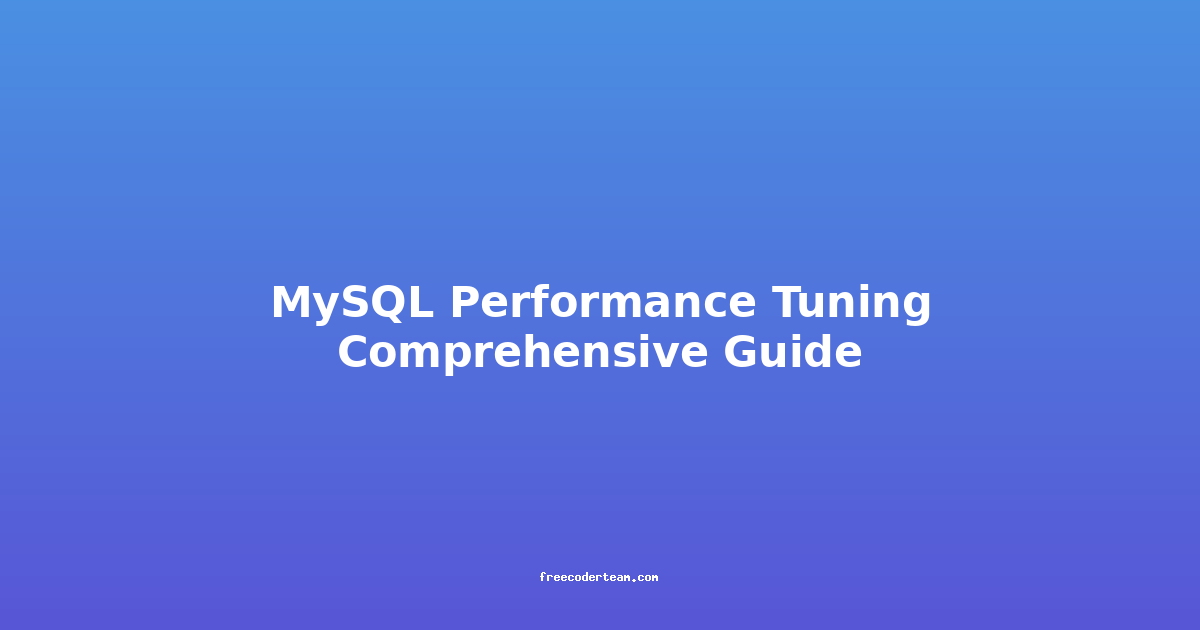MySQL Performance Tuning: A Comprehensive Guide
MySQL is one of the most widely used relational database management systems (RDBMS) in the world, powering everything from small applications to large-scale enterprise systems. However, as your application grows in complexity and traffic, MySQL's performance can become a bottleneck. Performance tuning is essential to ensure that your database remains responsive, scalable, and efficient.
In this comprehensive guide, we'll explore various aspects of MySQL performance tuning, including best practices, actionable insights, and practical examples. Whether you're a developer, database administrator, or system architect, this guide will help you optimize your MySQL database for better performance.
Table of Contents
- Understanding MySQL Performance
- Key Performance Metrics
- Tuning MySQL Configuration
- Query Optimization
- Database Schema Design
- Monitoring and Profiling
- Conclusion
Understanding MySQL Performance
Before diving into performance tuning, it's essential to understand what factors affect MySQL's performance. Key areas include:
- Hardware: CPU, memory, storage (SSD vs. HDD), and network.
- Database Configuration: How MySQL is set up and configured.
- Query Performance: How efficiently queries are executed.
- Schema Design: How data is structured and organized.
- Workload: The type and volume of operations (reads, writes, transactions).
Performance tuning is about balancing these factors to achieve optimal results.
Key Performance Metrics
To effectively tune MySQL, you need to monitor and analyze key performance metrics. These metrics provide insights into how your database is performing and where bottlenecks may exist.
Common Metrics
- CPU Usage: Indicates if the server is CPU-bound.
- Memory Usage: Tracks how much memory MySQL is using, especially the buffer pool.
- Disk I/O: Measures read/write operations on storage.
- Query Response Time: How long it takes to execute queries.
- Connections: Number of active connections to the database.
Tools for Monitoring
SHOW STATUS: Provides real-time statistics about MySQL's performance.SHOW VARIABLES: Displays current configuration settings.- Slow Query Log: Captures queries that take longer than a specified threshold.
- Third-Party Tools: Tools like Percona Toolkit, MySQL Enterprise Monitor, and Prometheus can provide deeper insights.
Tuning MySQL Configuration
MySQL's performance is heavily influenced by its configuration settings, which are stored in the my.cnf (Linux) or my.ini (Windows) file. Optimizing these settings can significantly improve database performance.
Optimizing my.cnf/my.ini
The default MySQL configuration is often not optimized for production environments. Here are some key settings to adjust:
Buffer Pool Size
The InnoDB Buffer Pool is one of the most critical settings for performance. It caches frequently accessed data and indexes, reducing the need for disk I/O.
# my.cnf
[mysqld]
innodb_buffer_pool_size = 8G # Adjust based on available memory
Guideline: Set innodb_buffer_pool_size to 70-80% of your server's total RAM for optimal performance.
InnoDB Settings
InnoDB is the default storage engine in MySQL and offers transactional capabilities. Tuning InnoDB settings can improve write performance and reduce disk I/O.
# my.cnf
[mysqld]
innodb_flush_method = O_DIRECT # Reduces disk I/O overhead
innodb_log_file_size = 2G # Increase log file size for larger transactions
innodb_flush_log_at_trx_commit = 2 # Trade consistency for performance
Note: innodb_flush_log_at_trx_commit = 2 provides better performance but reduces durability in case of a crash.
Query Cache
The query cache can improve performance for read-heavy workloads but may cause contention in write-heavy environments.
# my.cnf
[mysqld]
query_cache_size = 0 # Disable query cache if not needed
Guideline: Disable the query cache if your application has frequent writes or if the cache invalidates often.
Query Optimization
Query optimization is one of the most impactful areas of performance tuning. Poorly written queries can lead to slow response times and high resource usage.
Indexing Strategies
Indexes are critical for speeding up data retrieval. However, over-indexing can slow down write operations. Here are some best practices:
- Primary Keys: Always have a primary key, as it ensures uniqueness and improves query performance.
- Composite Indexes: Use composite indexes for queries that filter on multiple columns.
- Covering Indexes: Create indexes that include all columns referenced in the query to avoid table scans.
Example: Consider a table users with columns id, name, and email. If you frequently query by email, create an index:
CREATE INDEX idx_email ON users(email);
Explain Plan Analysis
The EXPLAIN statement provides insights into how MySQL executes a query. It helps identify bottlenecks and inefficiencies.
Example: Analyze a query:
EXPLAIN SELECT * FROM users WHERE email = 'john.doe@example.com';
Output:
+----+-------------+-------+------------+------+---------------+----------+---------+-------+------+----------+-------+
| id | select_type | table | partitions | type | possible_keys | key | key_len | ref | rows | filtered | Extra |
+----+-------------+-------+------------+------+---------------+----------+---------+-------+------+----------+-------+
| 1 | SIMPLE | users | NULL | ref | idx_email | idx_email | 767 | const | 1 | 100.00 | NULL |
+----+-------------+-------+------------+------+---------------+----------+---------+-------+------+----------+-------+
Insights:
type: Indicates the join type (refis good,ALLis bad).key: Shows which index is used.rows: Estimates the number of rows examined.
Avoiding Common Query Anti-Patterns
- Selecting All Columns (
SELECT *): Only select the columns you need. - Using
LIKEwith Leading Wildcards: Queries likeWHERE name LIKE '%john'cannot use indexes. - Unnecessary Subqueries: Simplify queries to reduce complexity.
- Lack of Indexes: Ensure that frequently queried columns are indexed.
Database Schema Design
How you design your database schema can significantly impact performance. Here are some best practices:
Normalization vs. Denormalization
- Normalization: Reduces redundancy and improves data integrity but may require more joins.
- Denormalization: Improves query performance by reducing joins but increases data redundancy.
Example: A normalized schema might have separate tables for users and orders, while a denormalized schema might combine them for faster queries.
Partitioning
Partitioning divides large tables into smaller, more manageable parts. This can improve query performance, especially for large datasets.
Example: Partition a logs table by date:
CREATE TABLE logs (
id INT AUTO_INCREMENT,
log_date DATE,
message TEXT,
PRIMARY KEY (id, log_date)
) PARTITION BY RANGE (YEAR(log_date)) (
PARTITION p2023 VALUES LESS THAN (2024),
PARTITION p2024 VALUES LESS THAN (2025),
PARTITION p_future VALUES LESS THAN MAXVALUE
);
Monitoring and Profiling
Monitoring is crucial for identifying performance issues before they become critical.
Using SHOW STATUS
The SHOW STATUS command provides real-time statistics about MySQL's performance.
Example: Check buffer pool usage:
SHOW STATUS LIKE 'Innodb_buffer_pool_pages_%';
Output:
+-----------------------------------+-------+
| Variable_name | Value |
+-----------------------------------+-------+
| Innodb_buffer_pool_pages_data | 1000 |
| Innodb_buffer_pool_pages_dirty | 50 |
| Innodb_buffer_pool_pages_flushed | 200 |
| Innodb_buffer_pool_pages_free | 200 |
| Innodb_buffer_pool_pages_misc | 50 |
| Innodb_buffer_pool_pages_total | 1300 |
+-----------------------------------+-------+
Slow Query Log
The slow query log captures queries that take longer than a specified threshold. It helps identify queries that need optimization.
Enable Slow Query Log:
# my.cnf
[mysqld]
slow_query_log = 1
slow_query_log_file = /var/log/mysql/slow-query.log
long_query_time = 2 # Log queries taking more than 2 seconds
Example: Analyze a slow query:
SELECT * FROM users WHERE created_at > '2023-01-01';
Add an index to improve performance:
CREATE INDEX idx_created_at ON users(created_at);
Conclusion
MySQL performance tuning is a continuous process that requires a deep understanding of your application's workload, database configuration, and query patterns. By optimizing MySQL's configuration, refining queries, and designing efficient schemas, you can significantly improve your database's performance.
Remember:
- Monitor regularly: Use tools like
SHOW STATUSand the slow query log to identify bottlenecks. - Tune incrementally: Make small changes and measure their impact.
- Balance trade-offs: Consider the trade-offs between performance, scalability, and data integrity.
With these best practices and actionable insights, you can ensure that your MySQL database remains fast, reliable, and scalable.
Resources for Further Reading:
By applying the techniques outlined in this guide, you'll be well-equipped to optimize your MySQL database for peak performance. Happy tuning! 🚀
Feel free to reach out if you have any questions or need further assistance!




